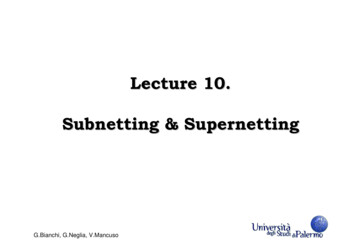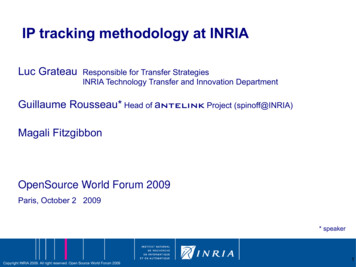
Transcription
Chapter 2Getting Started with HadoopApache Hadoop is a software framework that allows distributed processing of largedatasets across clusters of computers using simple programming constructs/models. It is designed to scale-up from a single server to thousands of nodes. It isdesigned to detect failures at the application level rather than rely on hardware forhigh-availability thereby delivering a highly available service on top of cluster ofcommodity hardware nodes each of which is prone to failures [2]. While Hadoopcan be run on a single machine the true power of Hadoop is realized in its abilityto scale-up to thousands of computers, each with several processor cores. It alsodistributes large amounts of work across the clusters efficiently [1].The lower end of Hadoop-scale is probably in hundreds of gigabytes, as it wasdesigned to handle web-scale of the order of terabytes to petabytes. At this scalethe dataset will not even fit a single computer’s hard drive, much less in memory.Hadoop’s distributed file system breaks the data into chunks and distributes themacross several computers to hold. The processes are computed in parallel on allthese chunks, thus obtaining the results with as much efficiency as possible.The Internet age has passed and we are into the data age now. The amount of datastored electronically cannot be measured easily; IDC estimates put the total size ofthe digital universe at 0.18 Zetabytes in 2006 and it is expected to grow tenfold by2011 to 1.8 Zeta-bytes [9]. A Zetabyte is 1021 bytes, or equivalently 1000 Exabytes,1,000,000 Petabytes or 1bn Terabytes. This is roughly equivalent to one disk drivefor every person in the world [10]. This flood of data comes from many sources.Consider the following: The New York Stock Exchange generates about one terabyte of trade data perday. Facebook hosts approximately 10 billion photos, taking up one petabyte of storage. Ancestry.com, the genealogy site, stores around 2.5 petabytes of data. The Internet Archive stores around 2 petabytes of data, and is growing at a rateof 20 terabytes per month.c Springer International Publishing Switzerland 2015 K.G. Srinivasa and A.K. Muppalla, Guide to High PerformanceDistributed Computing, Computer Communications and Networks,DOI 10.1007/978-3-319-13497-0 233
342 Getting Started with Hadoop The Large Hadron Collider near Geneva, Switzerland, produces around 15petabytes of data per year.2.1 A Brief History of HadoopHadoop was created by Doug Cutting, the creator of Apache Lucene, a widely usedtext search library. The Apache Nutch project, an open source web search engine,had a significant contribution to building Hadoop [1].Hadoop is not an acronym; it is a made-up name. The project creator, Doug Cutting,explains how the name came about:The name my kid gave a stuffed yellow elephant. Short, relatively easy to spell and pronounce, meaningless, and not used elsewhere: those are my naming criteria. Kids are goodat generating such.It is ambitious to build a web search engine from scratch as it is not only challengingto build a software required to crawl and index websites, but also a challenge to runwithout a dedicated operations team as there are so many moving parts. It is estimated that a 1 billion page index would cost around 500,000 to build and monthly 30,000 for maintenance [4]. Nevertheless, this goal is worth pursuing as Searchengine algorithms are opened to the world for review and improvement.The Nutch project was started in 2002, with the crawler and search system beingquickly developed. However, they soon realized that their system would not scale toa billion pages. Timely publication from Google in 2003, the architecture of GoogleFileSystem, called the GFS came in very handy [5]. The GFS or something like thatwas enough to solve their storage needs for the very large files generated as part ofthe web crawl and indexing process. The GFS particularly frees up the time spenton maintaining the storage nodes. This effort gave way to the Nutch Distributed FileSystem (NDFS) .Google produced another paper in 2004 that would introduce MapReduce to theworld. By early 2005 the Nutch developers had a working MapReduce implementation in Nutch and by the middle of that year most of the Nutch Algorithms wereported to MapReduce and NDFS.NDFS and MapReduce implementation in Nutch found applications in areas beyondthe scope of Nutch; in Feb 2006 they were moved out of Nutch to form theirown independent subproject called Hadoop. Around the same time Doug Cuttingjoined Yahoo! which gave him access to a dedicated team and resources to turnHadoop into a system that ran at web-scale. This ability of Hadoop was announcedthat its production search index was generated by the 10,000 node Hadoop cluster[6].
2.1 A Brief History of Handoop35In January 2008, Hadoop was promoted to a top level project at Apache, confirmingits success and its diverse active community. By this time, Hadoop was being usedby many other companies besides Yahoo!, such as Last.fm, Facebook, and the NewYork Times.The capability of Hadoop was demonstrated and publicly put at the epitome of thedistributed computing sphere when The New York Times used Amazon’s EC2 compute cloud to crunch through four terabytes of scanned archives from the paperconverting them into PDFs for the Web [7]. The project came at the right time withgreat publicity toward Hadoop and the cloud. It would have been impossible to trythis project if not for the popular pay-by-the-hour cloud model from Amazon. TheNYT used a large number of machines, about a 100 and Hadoop’s easy-to-use parallel programming model to process the task in 24 hours.Hadoop’s successes did not stop here, it went on to break the world record to becomethe fastest system to sort a terabyte of data in April 2008. It took 209 seconds to sorta terabyte of data on a 910 node cluster, beating the previous year’s winner of 297seconds. It did not end here, later that year Google reported that its MapReduceimplementation sorted one terabyte in 68 seconds [8]. Later, Yahoo! reported tohave broken Google’s record by sorting one terabyte in 62 seconds.2.2 Hadoop EcosystemHadoop is a generic processing framework designed to execute queries and otherbatch read operations on massive datasets that can scale from tens of terabytes topetabytes in size. HDFS and MapReduce together provide a reliable, fault-tolerantsoftware framework for processing vast amounts of data in parallel on large clustersof commodity hardware (potentially scaling to thousands of nodes).Hadoop meets the needs of many organizations for flexible data analysis capabilitieswith an unmatched price-performance curve. The flexibility in data analysis featureapplies to data in a variety of formats, from unstructured data, such as raw text, tosemi-structured data, such as logs, to structured data with a fixed schema.In environments where massive server farms are used to collect data from a varietyof sources, Hadoop is able to process parallel queries as background batch jobs onthe same server farm. Thus, the requirement for an additional hardware to processdata from a traditional database system is eliminated (assuming such a system canscale to the required size). The effort and time required to load data into another system is also reduced since it can be processed directly within Hadoop. This overheadbecomes impractical in very large datasets [14].The Hadoop ecosystem includes other tools to address particular needs:
362 Getting Started with HadoopFig. 2.1: Hadoop Ecosystem [14]Common: A set of components and interfaces for distributed filesystems and general I/O (serialization, Java RPC, persistent data structures).Avro: A serialization system for efficient, cross-language RPC and persistent datastorage.MapReduce: A distributed data processing model and execution environment thatruns on large clusters of commodity machines.HDFS: A distributed filesystem that runs on large clusters of commodity machines.Pig: A data flow language and execution environment for exploring very largedatasets. Pig runs on HDFS and MapReduce clusters [6].Hive: A distributed data warehouse. Hive manages data stored in HDFS and provides a query language based on SQL (and which is translated by the runtime engineto MapReduce jobs) for querying the data [7].HBase: A distributed, column-oriented database. HBase uses HDFS for its underlying storage, and supports both batch-style computations using MapReduce andpoint queries (random reads) [18].
2.2 Hadoop Ecosystem37ZooKeeper: A distributed, highly available coordination service. ZooKeeper provides primitives such as distributed locks that can be used for building distributedapplications [19].Sqoop: A tool for efficiently moving data between relational databases and HDFS.Cascading: MapReduce is very powerful as a general-purpose computing framework, but writing applications in the Hadoop Java API for MapReduce is daunting,due to the low-level abstractions of the API, the verbosity of Java, and the relativeinflexibility of the MapReduce for expressing many common algorithms. Cascading is the most popular high-level Java API that hides many of the complexitiesof MapReduce programming behind more intuitive pipes and data flow abstractions.Twitter Scalding: Cascading is known to provide close abstraction to the dauntingJava API using pipes and custom data flows. It still suffers from limitations andverbosity of Java. Scalding is Scala API on top of cascading that indents to removemost of the boilerplate Java code and provides concise implementations of commondata analytics and manipulation functions similar to SQL and Pig. Scalding alsoprovides algebra and matrix models, which are useful in implementing machinelearning and other linear algebra-dependent algorithms.Cascalog: Cascalog is similar to Scalding in the way it hides the limitations ofJava behind a powerful Clojure API for cascading. Cascalog includes logic programming constructs inspired by Datalog. The name is derived from Cascading Datalog.Impala: It is a scalable parallel database technology to Hadoop, which can be usedto launch SQL queries on the data stored in HDFS and Apache HBase without anydata movement or transformation. It is a massively parallel processing engine thatruns natively on Hadoop.Apache BigTop: It was originally a part of the Cloudera’s CDH distribution, whichis used to test the Hadoop ecosystem.Apache Drill: It is an open-source version of Google Drell . It is used for interactive analysis on large-scale datasets. The primary goals of Apache Drill are realtime querying of large datasets and scaling to clusters bigger than 10,000 nodes. Itis designed to support nested data, but also supports other data schemes like Avroand JSON. The primary language, DrQL, is SQL like [20].Apache Flume: It is responsible data transfer between ”source” and ”sink”, whichcan be scheduled or triggered upon an event. It is used to harvest, aggregate, andmove large amounts of data in and out of Hadoop. Flume allows different data formats for sources, Avro, files, and sinks, HDFS and HBase. It also has a querying
382 Getting Started with Hadoopengine so that the user can transform any data before it is moved between sourcesand sinks.Apache Mahout: it is a collection of scalable data mining and machine learningalgorithms implemented in Java. Four main groups of algorithms are: Recommendations, a.k.a. collective filtering Classification, a.k.a categorization Clustering Frequent itemset mining, a.k.a parallel frequent pattern miningIt is not merely a collection of algorithms as many machine learning algorithms arenon-scalable, the algorithms in Mahout are written to be distributed in nature anduse the MapReduce paradigm for execution.Oozie: it is used to manage and coordinate jobs executed on Hadoop.2.3 Hadoop Distributed File SystemThe distributed file system in Hadoop is designed to run on commodity hardware.Although it has many similarities with other distributed file systems, the differencesare significant. It is highly fault-tolerant and is designed to run on low-cost hardware. It also provides high-throughput to stored data, hence can be used to storeand process large datasets. To enable this streaming of data it relaxes some POSIXstandards. HDFS was originally built for the Apache Nutch project and later forkedin to an individual project under Apache [21].HDFS by design is able to provide reliable storage to large datasets, allowing highbandwidth data streaming to user applications. By distributing the storage and computation across several servers, the resource can scale up and down with demandwhile remaining economical.HDFS is different from other distributed file systems in the sense that it uses a writeonce-read-many model that relaxes concurrency requirements, provides simple datacoherency, and enables high-throughput data access [22]. HDFS prides on the principle and proves to be more efficient when the processing is done near the data ratherthan moving the data to the applications space. The data writes are restricted to onewriter at a time. The bytes are appended to the end of the stream and are stored inthe order written. HDFS has many notable goals: Ensuring fault tolerance by detecting faults and applying quick recovery methods.
2.3 Hadoop Distributed File System39 MapReduce streaming for data access. Simple and robust coherency model. Processing is moved to the data, rather than data to processing. Support heterogeneous commodity hardware and operating systems. Scalability in storing and processing large amounts of data. Distributing data and processing across clusters economically. Reliability by replicating data across the nodes and redeploying processing in theevent of failures.2.3.1 Characteristics of HDFSHardware Failure: Hardware failure is fairly common in clusters. A Hadoop cluster consists of thousands of machines, each of which stores a block of data. HDFSconsists of a huge
Getting Started with Hadoop Apache Hadoop is a software framework that allows distributed processing of large datasets across clusters of computers using simple programming constructs/mod-els. It is designed to scale-up from a single server to thousands of nodes. It is designed to detect failures at the application level rather than rely on hardware for high-availability thereby delivering a .











